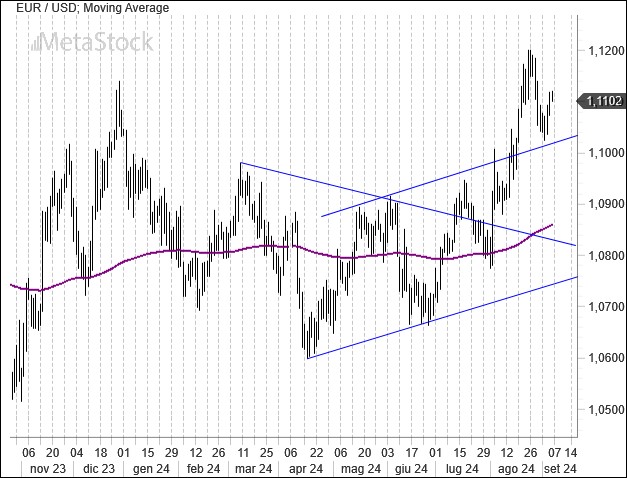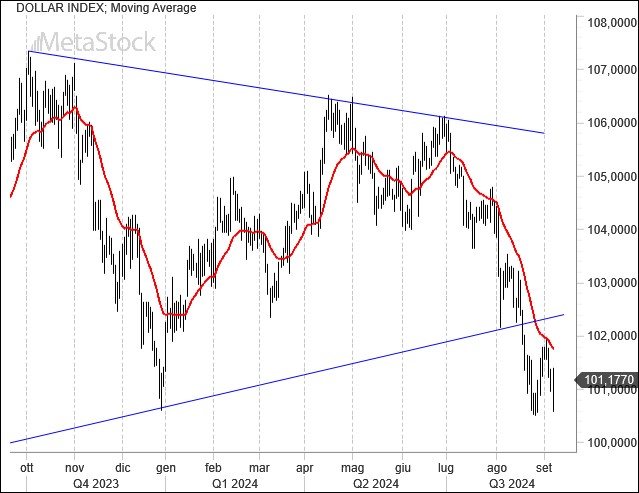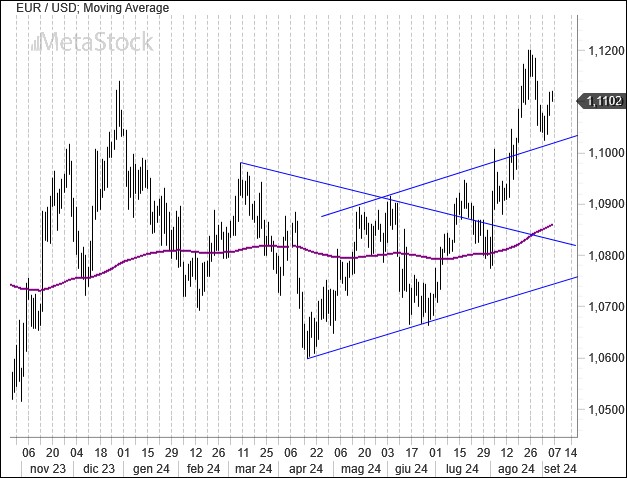- Fears of an economic slowdown, potentially leading to a recession, are spreading across trading floors following recent U.S. macroeconomic data, particularly on employment. The hope is for a more proactive stance from the Federal Reserve on interest rates as early as September.
- This week, the European Central Bank (ECB) is expected to cut interest rates to stimulate a sluggish European economy, particularly in Germany. However, inflation remains stubbornly above 2%, although a decline in energy prices should provide some relief.
- The Euro has confirmed a break above the 1.10 level against the U.S. dollar, eyeing resistance at 1.12. A break above that level could signal the bullish trend the markets have been waiting for, indicating further weakness for the dollar.
Recession Fears Grow
U.S. employment data confirms that the economic slowdown is underway. With just over 140,000 new payrolls added (slightly below expectations), and more notably, a downward revision of over 80,000 jobs in the previous two months, the Federal Reserve now has enough evidence that the time has come to cut rates in September—and do so urgently. Failure to act could risk a slowdown spiraling into an economic recession. The negative reaction in stock markets echoes these concerns.
The U.S. ISM manufacturing index has reignited fears of a recession. The headline figure remains below the 50-point mark, but more worrisome are the substantial inventory increases and a plunge in new orders to their lowest level in 14 months. Adding to this is a marginal rise in the price component, complicating the picture further.
The Fed’s Beige Book revealed that growth is either flat or slowing across most districts. One of the most closely watched reports by analysts, the Beige Book also highlighted that wage growth and overall inflation have been modest. This provides another green light for Fed Chair Jerome Powell to start reducing the cost of borrowing.
Meanwhile, the Eurozone is preparing for another rate cut from the ECB. A quarter-point cut is expected to provide some relief to the German economy, which continues to churn out negative forward-looking data (e.g., the contraction in ZEW and PMI indices). Eurozone retail sales figures were also weak, showing an annual decline of 0.1%. The only positive signal came from Germany, where new orders rose 2.9% in July.
Technical Analysis: Euro Bullish Momentum Builds as 1.12 Resistance Faces Key Test
From a technical standpoint, analysts are closely monitoring a bullish head-and-shoulders pattern that was validated by a long bullish candlestick in early August, following a textbook pullback before resuming its upward move. The 1.12 resistance level was tested, and a pause followed, but after the release of U.S. employment data, the Euro resumed its upward trajectory, confirming the bullish scenario.
With the head-and-shoulders pattern targets reached, the currency pair now needs to push decisively above the 1.12 level to aim for the 1.16/1.17 range. The Federal Reserve and the ECB will be the market movers that will provide clarity in the coming days.

The U.S. Dollar Index attempted a recovery but failed to surpass the moving average that has guided the downtrend since early July. Considering that this area coincided with the previous support linking the lows from July and December 2023, buyers of the dollar appear to be staying on the sidelines for now.
If the current phase of dollar weakness is nearing its end, a renewed move downward could be expected (now in progress), potentially forming a double bottom, but only if the support levels hold. Should the late August lows give way, the index could quickly drop toward the July 2023 lows.



Leave a Reply
You must be logged in to post a comment.